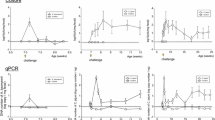Abstract
A variety of environment-associated gastrointestinal infections have been associated with the Aeromonas group of bacteria which contain both non-virulent strains as well as virulent strains within a particular species. This study monitors the colonization rates of colon tissue in a mouse-streptomycin dose/response model involving isolates of Aeromonas veronii biovar sobria obtained from human clinical specimens. The ability to successfully colonize mouse colon tissues by the human clinical isolates was then compared with the rates achieved in a previous study of Aeromonas isolates obtained from environmental drinking water samples. Results suggest that strains of Aeromonas isolated from drinking water environmental samples contain pathogenic and virulence capabilities similar to those seen in Aeromonas veronii clinical isolates from human infections.
Similar content being viewed by others
References
Balsalobre LC, Dropa M, Matte GR, Hatte MH (2009) Molecular detection of enterotoxins in environmental strains of Aeromonas hydrophila and Aeromonas jandaei. J Water Health 7(4):685–691
Bhowmik P, Bag PK, Hajra TK, De R, Sarkar P, Ramamurthy T (2009) Pathogenic potential of Aeromonas hydrophila isolated from surface waters in Kolkata, India. J Med Microbiol 58:1549–1558
Burke V et al (1984) Isolation of Aeromonas hydrophila from a metropolitan water supply: seasonal correlation with clinical isolates. Appl Environ Microbiol 48:361–366
Donohue MJ, Best JM, Smallwood AW, Kostich M, Rodgers M, Shoemaker JA (2007) Differentiation of Aeromonas isolated from drinking water distribution systems using Matrix-Assisted Laser Desorption/Ionization-Mass Spectrometry. Anal Chem 79:1939–1946
Egorov AI, Best JM, Frebis CP, Karapondo MS (2011) Occurrence of Aeromonas spp. in a random sample of drinking water distribution systems in the United States (in press)
Ferens WA, Hovde CJ (2010) Escherichia coli O157:H7: animal reservoir and sources of human infection. Foodborne Pathog Dis. doi:10.1089/fpd.2010.0673
Havelaar AH, Versteegh JFM, During M (1990) The presence of Aeromonas in drinking-water supplies in the Netherlands. Zentralblatt für Hygiene 190:236–256
Hayes SL, Rodgers MR, Lye DJ, Stelma GN, McKinstry CA, Malard JM, Vesper SJ (2007) Evaluating virulence of waterborne and clinical Aeromonas isolates using gene expression and mortality in neonatal mice followed by assessing cell culture’s ability to predict virulence based on transcriptional response. J Appl Microbiol 103:811–820
Janda JM, Abbott SL (2010) The genus Aeromonas: taxonomy, pathogenicity, and infection. Clin Microbiol Rev 23(1):35–73
Khajanchi BK, Fadl AA, Borchardt MA, Berg RL, Horneman AJ, Stemper ME, Joseph SW, Moyer NP, Sha J, Chopra AK (2010) Distribution of virulence factors and molecular fingerprinting of Aeromonas species isolates from water and clinical samples: suggestive evidence of water-to-human transmission. Appl Environ Microbiol 76(7):2313–2325
Lye DJ (2009) A mouse model for characterization of gastrointestinal colonization rates among environmental Aeromonas isolates. Curr Microbiol 58:454–458
Molnar B, Galamb O, Sipos F, Leiszter K, Tulassay Z (2010) Molecular pathogenesis of Helicobacter pylori infection: the role of bacterial virulence factors. Dig Dis 28(4–5):604–608
Pablos M, Remacha M-A, Rodriguez-Calleja J-M, Santos JA, Otero A, Garcia-Lopez M-L (2010) Identity, virulence genes, and clonal relatedness of Aeromonas isolates from patients with diarrhea and drinking water. Eur J Clin Microbiol Infect Dis 29:1163–1172
Sen K, Lye D (2007) Importance of flagella and enterotoxins for Aeromonas virulence in a mouse model. Can J Microbiol 53:261–269
Sen K, Rodgers M (2004) Distribution of six virulence factors in Aeromonas species isolated from US drinking water utilities: a PCR identification. J Appl Microbiol 97:1077–1086
Van Putten JP, van Alphen LB, Wosten MM, de Zoete MR (2009) Molecular mechanisms of campylobacter infection. Curr Top Microbiol Immunol 337:197–229
Yucel N, Erdogan S (2010) Virulence properties and characterization of Aeromonads isolated from foods of animal origin and environmental sources. J Food Protect 73(5):855–860
Acknowledgments
We would like to thank Marshfield Clinic (Marshfield, Wisconsin), Mark Borchardt, and Phillip Bertz for providing the clinical specimens used in this study. We also thank Maura Donohue for MALDI-MS analysis of the isolates.
Funding
The United States Environmental Protection Agency through its Office of Research and Development funded the research described here. It has been subjected to Agency review and approved for publication.
Author information
Authors and Affiliations
Corresponding author
Rights and permissions
About this article
Cite this article
Lye, D.J. Gastrointestinal Colonization Rates for Human Clinical Isolates of Aeromonas Veronii Using a Mouse Model. Curr Microbiol 63, 332 (2011). https://doi.org/10.1007/s00284-011-9982-5
Received:
Accepted:
Published:
DOI: https://doi.org/10.1007/s00284-011-9982-5




